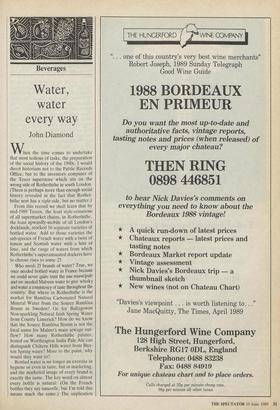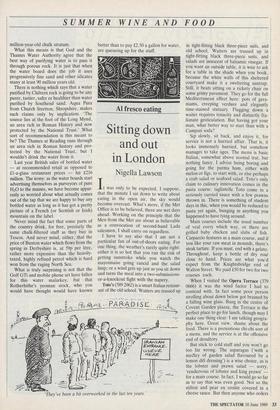Beverages
Water, water every way
John Diamond
hen the time comes to undertake that most tedious of tasks, the preparation of the social history of the 1980s, I would direct historians not to the Public Records Office, but to the inventory computer of the Tesco superstore which sits on the wrong side of Rotherhithe in south London. (There is perhaps more than enough social history revealed in the fact that Rother- hithe now has a right side, but no matter.)
From this record we shall learn that by mid-1989 Tescos, the least style-conscious of all supermarket chains, in Rotherhithe, the least upwardly-mobile of all London's docklands, stocked 16 separate varieties of bottled water. Add to those varieties the sub-species of French water with a twist of lemon and Scottish water with a hint of lime, and the range of waters from which Rotherhithe's superannuated dockers have to choose rises to some 25.
Who needs 25 brands of water? True, we once needed bottled water in France because we could never quite trust the eau municipals and we needed Malvern water to give whisky and water a consistency of taste throughout the country. But where in Rotherhithe is the market for RamlOsa Carbonated Natural Mineral Water from the Source Ramlosa Brunn in Sweden? Or for Ballygowan Non-sparkling Natural Irish Spring Water from County Limerick? How do we know that the Source Ramlosa Brunn is not the local name for Malmo's main sewage out- flow? How many Rotherhithe palates, honed on Worthington India Pale Ale can distinguish Chiltern Hills water from Bux- ton Spring water? More to the point, why would they want to? Bottled water is no longer an exercise in hygiene or even in taste, but in marketing, and the marketed image of every brand is exactly the same. The key word on almost every bottle is natural: (On the French bottles they say naturelle, but I'm told this means much the same.) The implication here is that somewhere, in a lock-up garage in Fulham, is some Arthur Daley character craftily bolting a couple of hydrogen atoms onto one of oxygen to produce dodgy artificial water which might taste the same but in some imperceptible way is a lesser water.
The second come-on is the table of contents. By tradition French waters have always been labelled with a chart showing the precise amount of sodium, chlorides, sulphates and so on as adduced .by the official analyst in 1921 (or whenever). This is only reasonable: it is worth knowing that Volvic has calcium 10.4 mg/1 and nitrates 4 mg/I in a country where in 1921 the stuff from the tap usually contained cattle slurry 104 mg/1 and Charlemagne's Revenge 265 mg/I. To know that Highland Spring Water had a conductivity in 1985 of 255, in a country where tap water has a conductivity of 255 does not mean a great deal.
Stranger still is the fact that some of the constituent 'natural' chemicals which fi- gure so proudly in these analyses are the same chemicals which the modern cardio- conscious set (the sort at which these waters are pitched) are warned to be wary of. A high sodium content might have been thought fine when the French analyses were made in the Twenties; now we know better.
There are other ploys which are more facile still. Spa mineral water from Bel- gium is, says the can, 'The ideal thirst quencher'. Well, of course it's the ideal thirst quencher: it's water. That's what water does, for God's sake: it quenches thirst.
Highland Spring, according to its label, is 'Calorie Free', unlike, I take it, all those fatty waters you see about the place. And here's another tip: when drinking Badoit, it is best served chilled. Chilled water, eh? Bet the Badoit food economists were up all night working that one out. It must have come to them at around the same time as the idea that as well as being 'the perfect accompaniment to good food and fine wines' it can even be served 'as a refreshing drink in its own right'. Chiltern Hills water takes the recipe line further: why not add it to fruit cordials or drink it with a slice of lemon? What, you mean like you can with water?
The biggest deal about all bottled water is 'the source'. All waters need a 'source' to sell themselves ever since the Source Per- rier became a tourist attraction in its own right. On the Volvic bottle, therefore, we have a diagramatic representation of the source: this strata is basalt, that granite, the other surface humus or, as we say on Gardeners' Question •Time, a humus sur- face. Chiltern Hills water, says the bottle, spends 50 years seeping through a 90-
SUMMER WINE AND FOOD
million-year-old chalk stratum.
What this means is that God and the Thames Water Authority agree that the best way of purifying water is to pass it through porous rock. It is just that when the water board does the job it uses progressively fine sand and other silicates many at least 90 million years old.
There is nothing which says that a water purified by Chiltern rock is going to be any purer, tastier, safer or healthier than water purified by Southend sand. Aqua Pura from Church Stretton, Shropshire, makes such claims only by implication. 'The source lies at the foot of the Long Mynd, an area rich in Roman History and now protected by the National Trust.' What sort of recommendation is this meant to be? The Thames at Reading runs through an area rich in Roman history and pro- tected by the National Trust, but I wouldn't drink the water from it.
Last year British sales of bottled water — at recommended retail as opposed to £1-a-glass restaurant prices — hit £216 million. The irony: as the water boards start advertising themselves as purveyors of pure H2O to the masses, we have become appar- ently so worried about what actually comes out of the tap that we are happy to buy any bottled water as long as it has got a pretty picture of a French (or Scottish or Irish) mountain on the label.
Never mind the fact that some parts of the country drink, for free, precisely the same chalk-filtered stuff as they buy in Tescos. And never mind, either, that the price of Buxton water which flows from the spring in Derbyshire is, at 59p per litre, rather more expensive than the heavily- taxed, highly refined petrol which is hard won from the raging North Sea. What is truly surprising is not that the Golf GTi and mobile phone set have fallen for this water malarkey, but that Rotherhithe's yeoman stock, who you would have thought would have known better than to pay £2.50 a gallon for water, are queueing up for the stuff.




























































 Previous page
Previous page